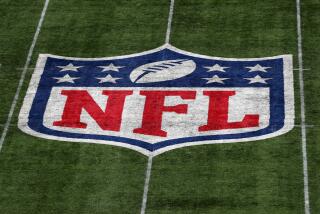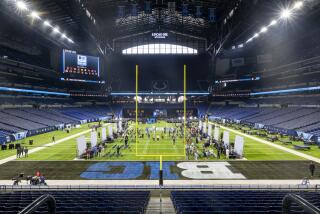Concussion settlement highlights difficulty of proving brain damage
- Share via
Thursday’s $765-million settlement between the National Football League and 4,500 retired NFL players underscores two key facts about traumatic brain injury: that it is difficult to prove and measure -- especially many years after the fact -- and that its link to neurocognitive problems that appear years later remains an enigma.
A mediated agreement does not mean that the retired NFL players’ injuries were caused by football, or even that they could have proven as much, said former U.S. District Judge Layn Phillips, the court-appointed mediator who brokered the proposed settlement. Nor, Phillips added, does it mean they could not prove it.
What’s clear is that proof either way will take years of further research -- and litigation. While evidence of a link between concussion and long-term cognitive and psychiatric consequences is mounting, it may take many more studies to clarify the relationship. And hard proof of cause-and-effect may remain elusive.
Concussion is indisputably as much a consequence of football at the professional level as wrecked knees, blown-out shoulders and bad backs. But even in the immediate wake of a ferocious blow to the head, traumatic brain injury can be difficult to show unless there is evidence of bleeding in or swelling of the brain.
CT scans can’t detect the brain’s massive metabolic disturbance in the wake of trauma. Nor can they measure the shearing of fat-covered axons -- the “white matter” that carries electrical impulses across the hemispheres of the brain and from region to region. And yet research suggests both of those processes may be key to concussion’s most damaging cognitive consequences.
Nor is damage evident on a CT scan conclusive. Even when such imaging does suggest brain injury, many will not immediately suffer the headaches, fatigue and loss of memory and concentration that signal the brain has been hurt. Others who may have come up “clean” on a CT scan may complain of subtle symptoms for weeks or months after a blow to the head.
So the diagnosis of concussion can be hard to make even when a player is rushed from the field to a hospital -- a rare response in a sport where players have been urged to “walk it off” and get back in the game. When depression, dementia, concentration difficulties and tremors appear years -- decades even -- after a player has retired, their link to blows to the head sustained while playing professionally is extremely difficult to prove.
One problem is that research suggests a person’s response to brain injury may be influenced by a host of factors -- social, genetic, perhaps even nutritional -- for which the National Football League is not responsible. The U.S. military, for which brain trauma has become an urgent priority, has sponsored many studies to identify the genes or life circumstances that might make a person more vulnerable to long-term effects of traumatic brain injury.
In the future, that knowledge may help weed out military recruits, or help steer NFL wannabes to non-contact sports instead. But retired NFL players may be left with the hard fact that, vulnerable or not, they played.
Another problem is the plaintiffs’ lack of baseline measures of cognitive performance. Those would allow a basis for comparison that might at least have correlated with a decline in cognitive health or psychiatric symptoms with blows to the head.
The settlement itself will set aside funds for “baseline exams” for all retired NFL players. But those come long after the blows to the head have stopped. They may provide early warning of -- and treatment for -- trouble ahead. But they’ll do little to establish a link between brain trauma sustained during play and later troubles.
Fortunately, baseline cognitive testing has increasingly become the norm for players as young as grade school, since it can help detect concussion-related changes and guide a physician’s decision to clear a concussed young player to return to play. Over time, researchers are certain to use that data to track players’ cognitive well-being as a function of playing time and blows to the head.
Finally, there’s the grim possibility that the small hits matter as much as the big ones -- a hypothesis for which there is growing evidence. When researchers at Purdue University wired the helmets of a high school football team in Lafayette, Ind., with accelerometers recently, they found that some players with no sign of concussion -- players who took many, less forceful blows to the head during the season -- began showing cognitive deficits as the fall wore on.
Whether those effects accumulate or the brain heals completely between seasons, no one yet knows. But it does suggest that professional football players, who generally cut their teeth (and rock their brains) for years on high school and college gridirons, may not have only the NFL to blame for their late-life problems.
On all these uncertainties, research has begun to establish a link between traumatic brain injury and later cognitive and psychiatric problems.
At Boston University’s Center for the Study of Traumatic Encephalopathy, the autopsied brains of dozens of former athletes have shown clear evidence of degenerative disease not seen in healthy brains.
Epidemiological studies have found that dementia and depression are more frequently diagnosed in former elite athletes who played contact sports than in people without such a history.
And at Columbia University and elsewhere, researchers are increasingly using new imaging techniques, including functional MRI that watches the brain at work, to detect immediate and longer-term changes in the brain’s performance following blows to the head.
Those have already yielded evidence that in the year after a concussion, scanned participants showed evidence of shrinkage in a region of the brain -- the anterior cingulate gyrus -- that’s implicated in depression. That may draw a clearer line between brain trauma and a greater propensity to mood disorders and suicide suggested by studies that have compared broad populations.
“We’re sort of at the beginning of learning about concussion and all of its long-term effects,” said NYU Langone Medical Center radiologist Dr. Yvonne Lui, who has conducted such research. “Right now, there’s a lot of data that shows that between groups, there are differences between control populations and athletes in contact sports. But what it means for any individual person is still questionable. So how you use that information to say anything about the long-term risk of any individual athlete is hard to put your finger on and accurately predict at this point.”
Meanwhile, research gauging the effects of smaller or accumulated blows to the head has been recognized by the MacArthur Assn. Kevin Guskiewicz, who has conducted some of the strongest work linking concussion with later dementia and depression, was long a thorn in the NFL’s side. But in 2010, NFL Commissioner Roger Goodell asked Guskiewiz to chair the NFL’s panel on safety equipment and playing rules, and Guskiewicz said yes.
[For the Record, 9:42 a.m. PDT Aug. 30: An earlier version of this online article incorrectly identified Dr. Yvonne Lui as a radiologist with Columbia University. She is with NYU Langone Medical Center.]







